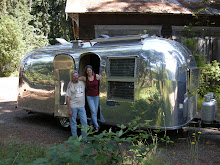
One thing you find out on a trip like this is how important your friends and family really are. Toward the end of August, after nearly two months on the road, we were in need of some time off the road to catch up on our blogging, and some much needed maintenance and repairs on the truck and trailer. The dusty, bumpy back roads we had traveled had taken their toll on the Doris Mae, and she needed a rest!
We pulled into La Crosse, WI where Kate’s sister Terri, her husband Todd, and their precocious 7 year old daughter Stella have their home. Todd is a master craftsman at Dave’s Guitars which houses one of the largest collections of classic electric guitars in the world. Terri is a full-time Mom, and is home schooling Stella with an enthusiasm and curriculum that any school district would be hard pressed to duplicate. We pulled Doris Mae into their driveway and set to work on catching up on our blog. For the next couple of days we would enjoy their hospitality and make the best of our time off the road.
Stella is a joy and a wonder every time we see her, and this time was no exception. I delighted in showing her the large toad I found living under their front porch. I also learned first hand why you should never let a 7 year old girl help you wash your truck, unless of course you need washing as well!
Maybe it was because I was family, but not someone she sees every day, or maybe it was because we had named the trailer after her Grandma, but one evening Stella came in while I was alone and said “Can I ask you something?” Having never had children, I was about as comfortable with this as the average parent is talking to their children about sex! But what the hell, I decided to give it a try. “Why did Grandma die?” she asked. I took a deep breath and answered back, “Why or how?” She thought for a minute and said “How?” “She got cancer” I said “and that’s what happens sometimes.” “Oh” she said, tears welling in her eyes “I miss her”. “We miss her too” I croaked trying hard to keep from exploding into tears, “Boy do we miss her”. This seemed to do the trick, and she gave me a big hug and trotted off to play. Having seemingly passed a children test with little or no experience, I prayed I wouldn’t be around when the time comes for the sex talk!
We had scheduled a public showing in nearby Virouqa, a small farming community that is near the center of one of the largest groups of organic farmers in the country. We were also going to drop in on the headquarters of the organic dairy cooperative Organic Valley just down the road in La Farge, WI so that we could learn more about their extensive operations and innovative programs.
After five days of enjoying their superb hospitality we bid them farewell, hit the road, did our show, and toured Organic Valley. But the “Tour De Family” had just begun. We were soon on our way to visit Red Wing, MN where Kate grew up, and where most of the rest of Kate’s family still lives.




















